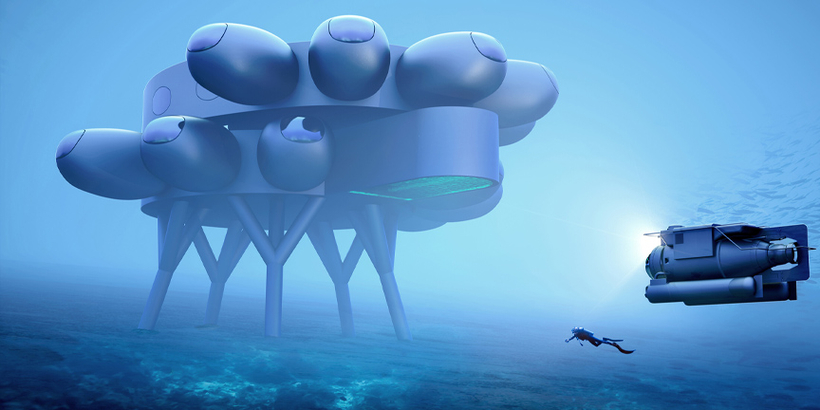It may not be 20,000 leagues under the sea, but an underwater base destined for a stretch of Caribbean seabed is drawing comparisons with the science-fiction world of Jules Verne.
The two-story structure is the brainchild of Fabien Cousteau, grandson of the French explorer Jacques, and is to be sited 60 feet underwater off the island of Curaçao. It is intended to be the ocean’s equivalent of the International Space Station (ISS) when completed in about three years’ time.
Called Proteus, after the Greek sea-god, it will accommodate laboratories, a greenhouse and sleeping quarters capable of supporting 12 scientists for days at a time. They will research climate change, look for new species of marine life and new medicines, and test technology, particularly in robotics and aquaculture.
Mr Cousteau hopes that the project, conceived with the Swiss designer Yves Béhar, will encourage worldwide cooperation in the same manner as the ISS, allowing scientists to study the submarine environment without having to decompress between dives, making research up to 30 times quicker.
Called Proteus, after the Greek sea-god, it will accommodate laboratories, a greenhouse and sleeping quarters capable of supporting 12 scientists for days at a time.
At present, the only equivalent facility is Aquarius in Florida, which was built by the US navy in 1986 and is a tenth of the size. Mr Cousteau spent 31 days filming there in 2014 as a tribute to his grandfather, a pioneer of scuba diving and marine conservation.
Mr Cousteau, who started scuba diving aged four, is the third generation of aquanaut in his family: his father, Jean-Michel, is a prominent film-maker, educator and environmentalist. He is continuing the work of his grandfather, who pioneered underwater habitats. Jacques, who died in 1997 aged 87, built the first submarine dwelling for two people, called Conshelf I, in 1962 at a depth of thirty-three feet off Marseille.
He spent 30 days in Conshelf II in the Red Sea the following year. The footage he filmed was turned into an Oscar-winning documentary, World Without Sun. His subsequent TV series is credited with inspiring a generation of marine biologists.

“We spend 100 times more on exploring space than exploring the oceans, but the oceans are our life-support systems,” Mr Cousteau said. “How can we make the right decisions for our future if we don’t know what’s going on down there? We’ve explored less than 5 percent of the ocean and 1 percent of the deep ocean and yet there are so many opportunities for scientific progress: there could be cures for cancer or new anti-viral drugs in the flora and fauna … and we can learn how to live in extreme environments, like on the dark side of the moon.”
“We spend 100 times more on exploring space than exploring the oceans, but the oceans are our life-support systems.”
He added: “My grandfather believed we could live beneath the sea but we have lost our way. It’s time to repair the human-ocean connection and prove that humanity’s future is bound up with what happens below the waves.”
Hugh Broughton, the architect responsible for Britain’s Halley VI and New Zealand’s Scott Antarctic research stations, said: “It does look like something out of Jules Verne. Extreme environments generate their own architecture to a degree and it does end up a bit sci-fi. It’s not too different from an isolated Antarctic base or the ISS but I expect it won’t look quite as sexy and curvaceous once they get to grips with all the engineering challenges.”
Powered by ocean thermal energy conversion, which exploits the temperature differential between warm water on the surface and cold water at depth, Mr Cousteau and Mr Béhar want the $130 million project to be the first of seven to eight stations, some of which could warn of tsunamis and hurricanes.
The construction of Proteus is due to start next month after a delay imposed by the pandemic, but a fundraising campaign has some way to go.
The base is expected to cost $2.9 million a year to run after the first three years. Mr Cousteau is keeping quiet about where the money will come from despite having won the backing of US institutions including Northeastern and Rutgers universities.
Marine Marvels
Floating tunnel: As part of its $46 billion coastal highway scheme, Norway is pioneering floating tunnels to cross some of its deepest fjords. Effectively air-filled concrete tubes, tethered 98 feet below the waves, they are cheaper than tunneling or bridge-building and, it is claimed, strong enough to survive collisions with ships or submarines. A variant proposed between Scotland and Northern Ireland is being studied by Downing Street.
Underwater restaurant: Norway also has the world’s largest underwater restaurant, which plunges to a depth of 16 feet with a huge panoramic window offering views of the seabed. Designed by the company Snohetta and opened last year, the restaurant doubles as a marine research center and will eventually become an artificial reef.
Aquatic warehouse: In 2017, Amazon filed a patent for submerged depots that could use lakes and reservoirs to hold products. Watertight cases would be deposited at the storage facility by truck, or even parachute, and summoned to the surface when a noise-activated air canister attached to them inflated a balloon.
The oceanscraper: Proposed by Vincent Callebaut, the Belgian architect, Aequorea would be capable of hosting 20,000 people, spiraling down from marinas on the surface. Shimizu Corporation, the Japanese company, claims its very similar scheme could be made a reality by 2030.

